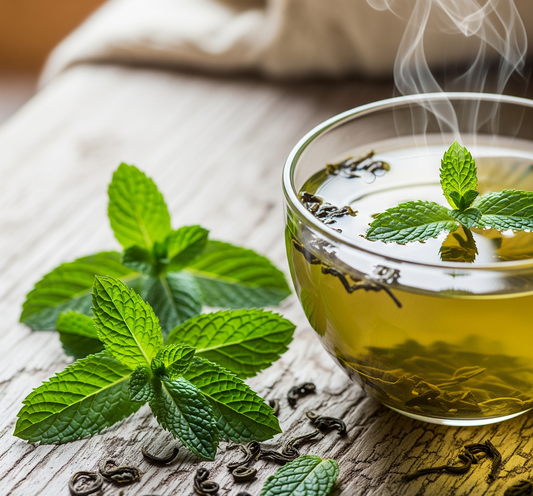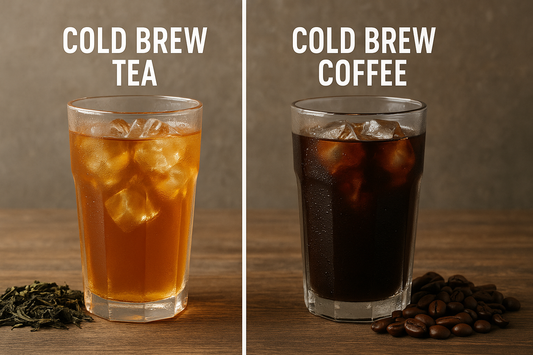Do teas expire? What happens to tea, packed and stored safely, after its best before date? In this blog, we've shared our experimentations with an accidental batch of aged fine teas!
Most packages of tea come with a Best Before date printed on the label. Usually, tea comes with a two year period before the expiry date. But can tea expire? And if your tea is past it's date, can you drink expired tea?
Teas do get old, they don’t expire, say, the way milk expires, or the way certain drugs expire. Their taste simply dulls over the time making the brew less flavorful.
So while it might not be harmful for you to drink your expired teas or your expired tea bags, your tea might be flavorless, weak and without any fragrance.
If you haven't stored your tea in an airtight jar, and you live in a humid environment, you should check your tea leaves for mold even if your tea leaves or tea bags haven't expired yet.
While it isn't dangerous to drink safely-stored tea leaves or tea bags even if they are expired, drinking moldy tea leaves can be very bad for you, even if you just bought them two weeks ago!
The “best by” dates stamped on the back of your tea pack is not exactly an expiration date. They are a suggestion as to how long the quality as intended during the packaging of the product will remain. It isn’t a concern of safety or even when the product is no longer good enough to be consumed.
When can tea 'expire'?
We can say that a tea can expire when the color, fragrance and flavor of the tea fades away.
While this can naturally happen past the Best Before date, tea can expire well before the expiry date, depending on how you have stored it.
We evaluate the freshness of loose leaf tea leaves by their color, their fragrance and their flavor.
- Color: Fresh and dry loose leaf tea leaves have a deep color, whether they be white tea, silver needles, green teas, which are usually a deep and vibrant shade of green, Oolongs, which can range from being on the green side to a dark red side, or black or red teas.
- Fragrance: When you open your sealed package or sealed jar of dry tea leaves, the aroma of the tea leaves should be strong and pronounced. When taking in the scent of the tea leaves, you should be able to pick out fresh notes of fragrance. The aroma of fresh dry leaves shouldn't be too subtle, and shouldn't smell damp or musty, which can be indicators of mold.
- Flavor: Once brewed for three to five minutes or as instructed by the package of tea, your fresh tea should have a wafting aroma and, depending on its grade, the tea should have complex and layered flavors. If your tea suddenly tastes bland, if the color, fragrance and flavor are weaker than it was previously, your tea leaves might have gone stale.
The taste of tea leaves dull over time due to exposure to air, sunlight or humidity. That means that teas that aren't stored will lose their flavor and aroma faster, and they might even become dull and weakly flavored far before their best before dates, even in the matter of a few months, if they are left open, and unsealed.
How Can I Store Tea to Preserve Teas Expiring:
All tea leaves, whether they come loose or whether they come in a bag, are precious. Himalayan teas, and other high altitude teas, are a labor of love: they are farmed, plucked and crafted with great love and dedication. Most teas are a result of centuries of tea knowledge that tea masters have perfected through the balanced mastery of nature, art, science, and spirituality. The better we care for these leaves, the longer they will last, and the less likely they will be to expire.
As we learned above, exposure to sunlight, air and humidity can not only make our tea leaves stale, they can also cause mold to grow on our tea leaves (a disaster, any loose leaf lover would say). So while storing our tea leaves, we have to keep in mind to shelter them from these things by transferring our teas in air-tight jars or cases, and ensuring that they are kept in a cool and dry place.
Another factor to consider while storing teas is ensuring that the leaves are not stored alongside heavy fragrances like spices, dried herbs, cigarettes, or baking products. Tea leaves are highly absorbent of flavors, and storing your leaves alongside stronger flavors can change the authentic taste of your tea.
An Experiment with 'Expired' Tea Leaves by Tea Experts:
In the world of beverages, aging is almost always associated with wines. Teas are rarely considered for its aging. This aged like a fine wine, like wine things get better with age. These quotes make a round every few months in social media and it is true that wines do age fine. Of course, I've met people who wonder if teas expire and a little over a year ago, I experienced the mastery of an unintentionally aged tea myself.
It was the first I’d ever seen or tasted myself. Tea has been and always will be a mystery and this incident simply solidified the vastness of what this brew is capable of.
Earlier this year, I got my hands into a batch of our tea from Kanchanjangha Tea Estate and Research Center. The classic wooden tea box instantly took me back to the factory where the tea had once been processed. I opened the packet and found myself quite a pleasant surprise! The earthy and fruity aromas burst out of the packet to reveal some finely sorted tea leaves. It was rather brownish in color with quite a lot of tips. I immediately knew it was our classic second flush black tea- SFTGFOP1.

With a lot of questions and curiosity in mind, I prepared a tasting set to really understand what this tea had in store for me.
I set a classic factory tasting parameters of 5 minutes timer, 212 F, 2 grams of tea, 8 oz of water and I was ready to dive into it.
When the timer went off, I placed the cup in the bowl, let the infusion leave the cup to a bowl! I opened the cup to a delightful smell of fruity aromas that transformed into the infused leaves particularly well. As I played around with the coppery leaves, the fresh earthy aromas filled my nose and I was excited to take the first slurp.
The first long slurp brought only a wave of disbelief. The second slurp; an even longer one, played around in my tongue all around the mouth. The tea had quite a robust body with a tannic but fruity finish.
I enjoyed the tea quite a lot but I still couldn’t believe how fresh everything was. This was in no way a fresh batch of tea and so I was in disbelief.
This tea was supposed to taste bland and even somewhat stale but I found none of that here.

I basically summed it up to my personal bias. After all this tea has been a part of my life. I thought this was a classic case of denial even though it had never happened to me before. I was confident enough to distinguish the quality of the tea, especially ones from our very own farm. Until of course this mystery tea.
So I did this experiment.
I sent this tea to five friends whose taste palates were significantly more mature and versatile than mine. I told them I would only reveal the story of the tea once they provided honest feedback and nothing else whatsoever. Following were their responses.
Jeremy Wickenheiser:
Jeremy is a co-owner and farmer at the Bella Vista Tea Company
My dad and I did a number of infusions from a 5-gram serving of it this afternoon and we both enjoyed it. It was a tea we would both drink again. Wow! I am honored that you sent me some of the tea from that special box. Thank you and no, it definitely was not stale at all. It was delicious - my dad and I both enjoyed it. Yes, that is definitely fascinating and to be honest, I think aging tea is very interesting. I know there are people that collect and age teas just like wines. Personally, I have a number of tea cakes/bricks that I am aging.
Dan Robertson:
Dan is the owner of The Tea House, World Tea Tours and Robertson*Tea
I really like this one! The mango taste was so strong, right at first. It tasted almost like a flavoring was added. If it is natural, it is great. The tea its self is nicely made, good laef appearance and general uniformity.
Liquor color was bright and rich. The smaller brokens and tips made it slightly cloudy but ok. Infused leaf color was rich and warm brown tones with some noticeable luster. Here are my notes:
Brewing method:
2.5g
190 degrees F
3 minutes.
Water source:
Tap = Softened Well water
Dry leaf appearance: Dark brown with some green leaves and pieces. Some tips. Lightly twisted with even rolling. My guess is a slightly less oxidized 2nd flush from China varietal.
Dry Aroma:
Dry, leafy, fairly mild. Some woody notes but not musty. Some richness.
Infused leaf:
Dark brown, large, choppy leaves, Firm. Glossy luster. Some red tints. Uniform size.
Infused aroma:
Winey, mild chocolate, rich, baked, hints of light fermentation.
Liquor color:
Deep copper red with brown tints. Yellow halo. Bright but a bit cloudy.
Flavor:
Mangoes!! Sweet, fruity, rich, light acceptable astringency. Baked. Flavor lingers, both the sweet and astringency. Good returning sweetness in the throat.
Babette Donaldson:
Babette is the founder at International Tea Sippers Society
I've enjoyed this tea because of it's balance between the very slight astringency that gives it freshness and a deeper resonance that builds body in the cup. I pushed it with time and temperature and a very long/strong cupping and still found it still very smooth. Using this method to concentrate the liquor works well with this tea. But I also tested multiple infusions and found it to be vigorous throughout each one. It offers many different personalities. So, this makes me think that it is a second flush and that the processing might include some rolling during the oxidation process.
Was I close on anything? Final thoughts are that this is a black tea that is very forgiving to beginners and gives you a lot of value in the cup. I believe you can have a wide audience for this tea. Does it have a name and a story yet?
After these reviews, I could safely say I wasn’t just making up the freshness of this old tea. I was relieved to be able to completely trust my palate and also a sense of pride to have this amazing batch of tea come from my own tea garden.
You may ask me why the sense of pride, well it’s because this tea was almost half a decade old. It was processed and packaged in in June 2014 to be precise. Here’s a look at the back of the packaging.

I had secured these boxes of tea (approx. 26 units) which were sent in 2014 to my sister to sell them in a small store that they operated in Connecticut. When they moved to Texas they just stored these teas in their basement and actually had forgotten about it. Earlier in February when they sold the house, I was helping them move and there lay these special tea boxes that I have treasured since.
For me, this specific incident answered the infamous question of tea’s expiry dates. There really is no expiry date for a good quality of tea that is packaged and stored well.
I’d love to hear your thoughts on this mystery tea if you’d like to experiment yourself! Test your palate and tea knowledge with this mystery tea. You can even do a blind tasting with others in your cabinet or from our portfolio and even challenge your friends to recognize the mystery tea. Let us if you want to know more!




